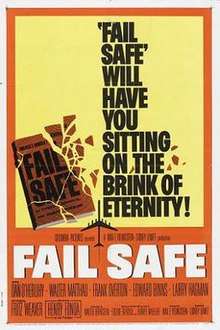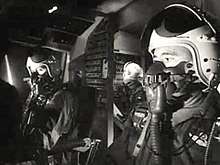Fail Safe (1964 film)
Fail Safe is a 1964 Cold War thriller film directed by Sidney Lumet, based on the 1962 novel of the same name by Eugene Burdick and Harvey Wheeler. It portrays a fictional account of a nuclear crisis. The film features performances by actors Henry Fonda, Dan O'Herlihy, Walter Matthau Frank Overton, Larry Hagman, Fritz Weaver, Dana Elcar, Dom DeLuise and Sorrell Booke.
| Fail-Safe | |
|---|---|
 Theatrical release poster | |
| Directed by | Sidney Lumet |
| Produced by | Sidney Lumet Charles H. Maguire Max E. Youngstein |
| Screenplay by | |
| Based on | the novel Fail-Safe by Eugene Burdick Harvey Wheeler |
| Starring | |
| Cinematography | Gerald Hirschfeld |
| Edited by | Ralph Rosenblum |
Production company | |
| Distributed by | Columbia Pictures |
Release date |
|
Running time | 112 minutes |
| Country | United States |
| Language | English |
| Box office | $1.8 million (rentals)[1] |
Fail Safe describes how Cold War tensions between the Soviet Union and the United States lead to an accidental thermonuclear first strike after an error sends a group of US bombers to bomb Moscow.
In 2000, the novel was adapted again as a televised play starring George Clooney, Richard Dreyfuss and Noah Wyle, and broadcast live in black and white on CBS.
Plot
During a VIP visit to the headquarters of the Strategic Air Command (SAC), at Offutt Air Force Base in Omaha, Nebraska, the Air Force's early warning radar indicates that an unidentified aircraft has intruded into American airspace. Shortly after, the "intruder" is identified as an off-course civilian airliner and the alert is cancelled, but a computer error causes one American bomber group to receive apparently valid orders for a nuclear attack on Moscow. Attempts to rescind this order fail because a new Soviet countermeasure jams American radio communications. Unable to obtain confirmation or denial of the order, Colonel Jack Grady (Edward Binns), the US bomber group's commander, follows the order and commands his group to continue to their target.
The president of the United States (Henry Fonda) and his advisers attempt to recall the bombers or shoot them down. Communications are opened with the Soviet chairman in which mistakes on both sides (the orders to the American bombers and the Soviet jamming) are acknowledged. The jamming ceases, but the crew follows their training, dismissing the subsequent counter-orders they receive as a Soviet ruse.
The President struggles to find a solution that will stop the Soviet Union from counter-attacking; if he fails, a nuclear holocaust will be unavoidable. He offers to sacrifice an American target to appease the skeptical Soviets and prove that the attack was indeed an error, and he orders an American bomber towards New York City. The President's advisers in the Pentagon discover that in doing so, the President is sacrificing the First Lady, who is visiting New York City.
A single American bomber reaches Moscow and destroys it. The President then orders General Black (Dan O'Herlihy), whose wife and children live in New York, to make a corresponding nuclear attack on New York, using the Empire State Building as ground zero. After releasing the bombs, Black kills himself. The last moments of the film show images of people in New York going about their daily lives, unaware of the coming disaster.
Cast

- Henry Fonda as the President
- Dan O'Herlihy as Brigadier General Warren A. "Blackie" Black, USAF
- Walter Matthau as Professor Groeteschele
- Frank Overton as General Bogan, USAF
- Fritz Weaver as Colonel Cascio, USAF
- Edward Binns as Colonel Jack Grady, USAF
- Larry Hagman as Buck, the President's interpreter
- William Hansen as Defense Secretary Swenson
- Russell Hardie as General Stark
- Russell Collins as Gordon Knapp
- Sorrell Booke as Congressman Raskob
- Nancy Berg as Ilsa Woolfe
- John Connell as Thomas
- Frank Simpson as Sullivan
- Hildy Parks as Betty Black
- Janet Ward as Helen Grady
- Dom DeLuise as Technical Sergeant Collins, USAF
- Dana Elcar as Mr. Foster
- Stewart Germain as Mr. Cascio
- Louise Larabee as Mrs. Cascio
- Frieda Altman as Mrs. Jennie Johnson
Production
The film was shot in black and white, in a dramatic, theatrical style with claustrophobic close-ups, sharp shadows and ponderous silences between several characters. Except for radio background during a scene at an Air Force base in Alaska, there is no original music score (only the electronic sound effects act as the film’s main and end title music). With few exceptions, the action takes place largely in the White House underground bunker, the Pentagon war conference room, the SAC war room, and a single bomber cockpit (a "Vindicator bomber"). Shots of normal daily life are seen only after the title opening credits and in the final scene depicting an ordinary New York City day, its residents entirely unsuspecting of their imminent destruction, each scene ending with a freeze-frame shot at the moment of impact.
The Soviets are not depicted in the film. The progress of the attack is followed on giant, electronic maps in the Pentagon War Room and SAC Headquarters. Conversations with the Soviet Premier (Russian language occasionally heard in the background on the "Hot-Line") are translated by an American interpreter (Larry Hagman). Suspense builds through dialog between the President and other officials, including an advisor to the Department of Defense, Professor Groeteschele (Walter Matthau), an old college friend of the President, General Black (Dan O'Herlihy) and SAC commander General Bogan (Frank Overton). The character of Groeteschele was inspired, according to Lumet's audio commentary on the film, by military strategist Herman Kahn.[2]
The "Vindicator" bombers (an invention of the novelists) are sometimes represented in the film with stock footage of Convair B-58 Hustlers. Fighters sent to attack the bombers are illustrated by film clips of the Lockheed F-104 Starfighter, Convair F-102 Delta Dagger, Dassault Mirage III and McDonnell F-101 Voodoo. Stock footage was used because the United States Air Force declined to cooperate in the production, disliking the premise of a lack of control over nuclear strike forces.[3] The scene depicting bombers taking off was stock footage of a single B-58 takeoff edited to look like several bombers taking off in succession. A nightmare quality is imparted to many of the flying sequences by depicting the planes in photographic negative. In several of the negative sequences the "Soviet interceptors" were actually French Mirage fighters with Israeli markings.
Reception
When Fail Safe opened in October 1964, it garnered excellent reviews, but its box office performance was poor. Its failure rested with the similarity between it and the nuclear war satire Dr. Strangelove, which had appeared in theaters first, in January 1964. Still, the film later was applauded as a Cold War thriller. The novel sold through to the 1980s and 1990s, and the film was given high marks for retaining the essence of the novel.[4] Over the years, both the novel and the movie were well received for their depiction of a nuclear crisis, despite many critical reviews rejecting the notion that a breakdown in communication could result in the erroneous go-command depicted in the novel and the movie.[3]
Lawsuit
Fail Safe and Dr. Strangelove were both produced in the period after the Cuban Missile Crisis, when people became much more sensitive to the threat of nuclear war. Fail Safe so closely resembled Peter George's novel Red Alert, on which Strangelove was based, that Strangelove screenwriter/director Stanley Kubrick and George filed a copyright infringement lawsuit.[5] The case was settled out of court.[6] The result of the settlement was that Columbia Pictures, which had financed and was distributing Strangelove, also bought Fail Safe, which had been an independently financed production.[7] Kubrick insisted that the studio release his movie first.[8]
See also
- The Bedford Incident, a 1965 film based on a novel about an engagement between an American destroyer and a Soviet submarine in the North Atlantic.
References
Notes
- "Big Rental Pictures of 1964". Variety, January 6, 1965, pg 39.
- https://www.vanityfair.com/hollywood/2020/05/shut-in-movie-club-fail-safe-coronavirus
- "Fail-Safe (Reviews)." Archived 2012-10-12 at the Wayback Machine strategypage.com. Retrieved: September 5, 2012.
- Erickson, Hal. "Fail Safe (1964)." The New York Times. Retrieved: October 24, 2009.
- Scherman, David E. (March 8, 1963). "in Two Big Book-alikes a Mad General and a Bad Black Box Blow Up Two Cities, and then— Everybody Blows Up!". Life Magazine. p. 49. Retrieved August 18, 2017.
- Schlosser, Eric (2014). Command and Control: Nuclear Weapons, the Damascus Accident, and the Illusion of Safety. Penguin. p. 297. ISBN 9780143125785.
- Schulman, Ari N. (October 7, 2014). "Doomsday Machines". Slate. Retrieved July 21, 2020.
- Jacobson, Colin. "Review:Fail-Safe: Special Edition (1964)." dvdmg.com, 2000. Retrieved: November 21, 2010.
Bibliography
- Dolan Edward F. Jr. Hollywood Goes to War. London: Bison Books, 1985. ISBN 0-86124-229-7.
- Evans, Alun. Brassey's Guide to War Films. Dulles, Virginia: Potomac Books, 2000. ISBN 1-57488-263-5.
- Harwick, Jack and Ed Schnepf. "A Viewer's Guide to Aviation Movies". The Making of the Great Aviation Films, General Aviation Series, Volume 2, 1989.
- LoBrutto, Vincent. Stanley Kubrick: A Biography. New York: Da Capo Press, 1999. ISBN 978-0-306-80906-4.
External links
| Wikiquote has quotations related to: Fail Safe (1964 film) |
- Fail Safe at the TCM Movie Database
- Fail Safe on IMDb
- Fail Safe at Rotten Tomatoes
- Fail Safe at AllMovie
- Fail Safe at the American Film Institute Catalog
- Fail Safe: Very Little Left of the World an essay by Bilge Ebiri at the Criterion Collection